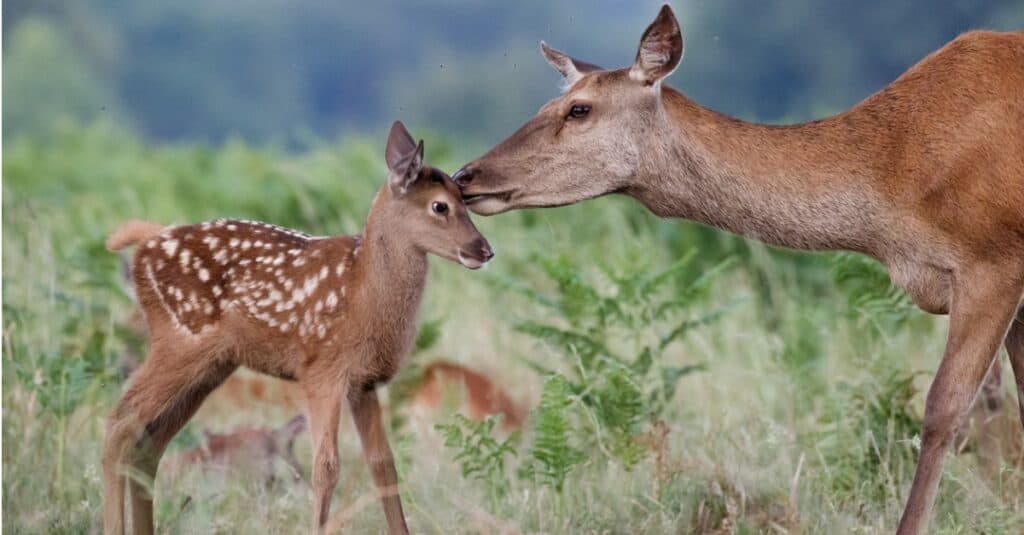Quick Answer:
- A deer’s winter coat has guard hairs over a thick undercoat that keeps its body warm in cold winter months.
- Deer are heavily insulated to the point that their body heat won’t escape, plus they don’t feel the cold from the snow.
- They have muscles to help them adjust the fur on their bodies for maximum warmth.
When temperatures drop in the winter, most people stay indoors to keep warm. If you live in an area where it gets really cold you may wrap yourself in a warm blanket and sip some tea or hot chocolate.
While you have a warm place to stay indoors, wild animals have to find ways to stay warm outdoors. Deer are just one example. Have you ever wondered how deer stay warm in the winter when it gets bitterly cold and windy? Do they hibernate like bears, snakes, and skunks? Where do they sleep in the winter?
Get ready to find out how deer stay warm over the cold weather months along with other interesting facts about these majestic animals.
How Do Deer Stay Warm in the Winter?
These hoofed creatures are hardy animals able to endure cold weather. In fact, biologists have discovered many different ways that deer stay warm in the winter.
In the autumn, white-tailed deer and other deer species consume an increased amount of food to add an extra layer of fat to their body. This is a behavior of many animals living in areas where it gets really cold in the winter. Along with eating more food, these mammals begin to eat different types of foods.
A deer’s winter coat has guard hairs over a thick undercoat that helps keep its body warm during winter. Deer are heavily insulated that even when it’s very cold, their body heat won’t escape. Additionally, deer don’t feel the cold from the snow. They even have muscles to help them adjust the fur on their bodies for maximum warmth.
In the warm weather months, deer eat a diet of grass, stems, leaves, twigs, and other plant life. These foods are low in calories and give deer the energy they need to thrive in the spring and summer. When the fall season arrives, deer add berries and nuts to the menu.
Why? Because berries and nuts are high-calorie foods that can help a deer quickly add to the layer of fat they need to survive the cold. They have to prepare their bodies for a season when food is not so easy to find.

©shaftinaction/Shutterstock.com
Staying Warm with a New Coat
A special coat also helps deer to stay warm in the wintertime. In the fall season, this animal sheds the coat it has had all spring and summer. It begins to grow a new, much thicker coat in preparation for winter weather.
The design of this mammal’s winter coat has a lot to do with how it stays warm and dry. The top layer of its coat is made up of hollow guard hairs. When snow or rain hits the guard hairs in a deer’s coat, the moisture just slides off. This keeps the coat from becoming soaked with moisture. That’s a good thing especially when temperatures are dropping fast!
The hollow nature of this animal’s guard hairs also serves the purpose of trapping heat near its body. If a deer were a house, its hollow guard hairs would be the insulation in its walls. Some scientists that spend time observing these animals have reported seeing thin layers of snow on the backs of several deer.
The snow is not melting due to its coat of hollow guard hairs. The animals simply shake off the snow!
Its special coat absorbs more sunlight on winter days. The sunlight filters down and adds to the warmth of the animal’s body.
Moving Less to Stay Warm
As with many other types of animals, the behavior of deer changes in the winter months. In the warm spring and summer months, you may see deer running around, playing, or eating in a field. Their physical activity slows down a lot in the winter. A deer becomes less active causing its metabolism to slow down. In fact, it decreases its activity level by fifty percent.
When an animal’s metabolism slows down, it doesn’t require as much food as it would with a normally functioning metabolism. This is helpful especially when food is scarce in the wintertime.

©JMrocek/Shutterstock.com
Finding Warm Shelter
Finding appropriate shelter is another way that deer stay warm in the winter. They search for areas where the cold winds are blocked and where they have shelter from above. This could be in a conifer forest or at the edge of a field.
Oftentimes, deer stand beneath tall pine trees that have lots of needles to block falling snow and rain. Or, they may gather on a hill with a line of evergreen trees blocking the wind. They’re likely to choose an area that receives many hours of sunlight during the day. This type of place is sometimes called a deer yard.
A deer yard may contain dozens or more deer. They are all there to get protection from the cold and share the body heat of the other deer in a herd. In addition, there is likely to be a large food source in the vicinity of the deer yard. This is another reason why deer gather there!
Deer are social animals so it’s not surprising to see them gathered in a herd during the winter or any season. Forming a herd provides them with some protection against wolves, mountain lions, coyotes, and other predators. When a predator approaches the herd, the deer stampede. In this rush out of the area, a wolf or other predator may not be able to grab one of the deer from the herd.
Thank you for reading! Have some feedback for us? Contact the AZ Animals editorial team.








